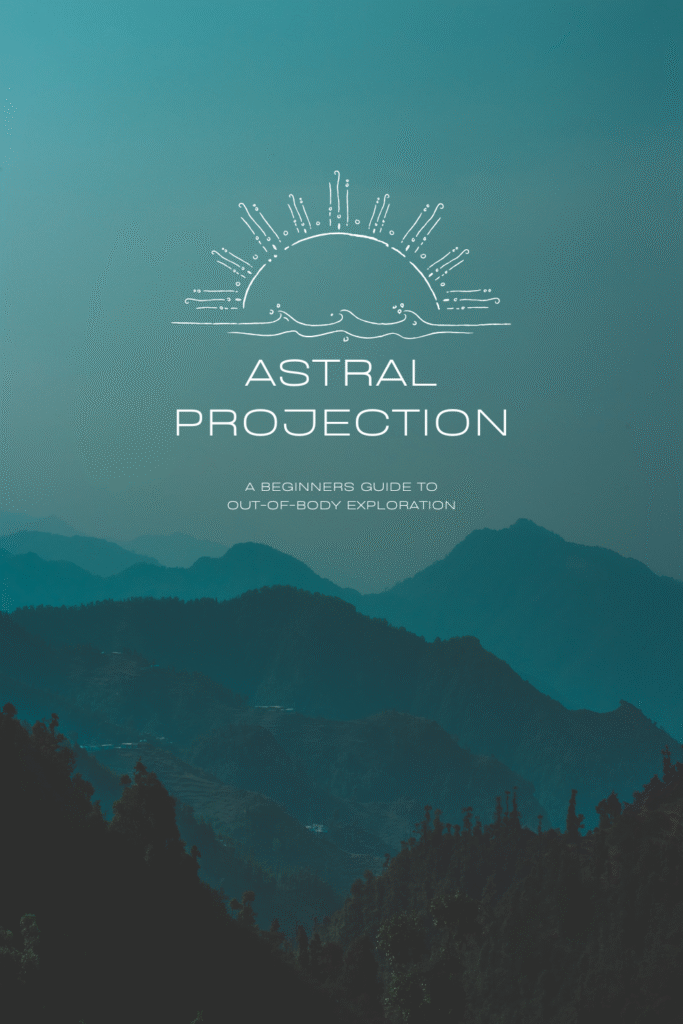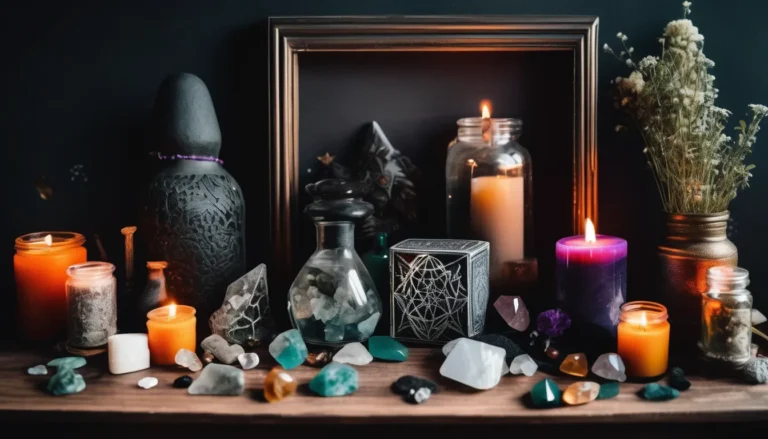Astral Projection: A Beginner’s Guide to Out-of-Body Exploration
We are a participant in the Amazon Services LLC Associates Program and other affiliate programs. Affiliate advertising is designed to provide a means for us to earn fees by linking to Amazon.com and other affiliated sites. This post may contain affiliate links.
Have you ever wondered what it would be like to leave your physical body and explore other realms with your consciousness? Astral projection—also known as an out-of-body experience (OBE)—is a powerful spiritual practice that allows you to do just that.
Whether you’re curious about connecting with your higher self, exploring the astral realm, or simply expanding your consciousness, this beginner’s guide will walk you through what astral projection is, how it works, and how to start your own safe and meaningful practice.

What Is Astral Projection?
Astral projection is the intentional act of separating your consciousness (or astral body) from your physical body to travel in non-physical dimensions. This experience is different from dreaming—while dreams can be symbolic or subconscious, astral projection involves conscious awareness as you move through other planes of existence.
The astral realm is believed to be a higher vibrational layer of reality, filled with energies, beings, and knowledge beyond the physical world.
Is Astral Projection Real?
From a spiritual perspective, yes.
Astral projection has been practiced for thousands of years in various cultures—found in ancient Egyptian texts, shamanic traditions, Tibetan Buddhism, and Western esoteric teachings.
From a psychological or scientific standpoint, OBEs are often explained as altered states of consciousness, but many practitioners report consistent, verifiable, and transformative experiences that transcend normal dreams or imagination.
Regardless of belief, astral projection can be a profound tool for inner exploration, healing, and awakening.
Why People Practice Astral Projection
People are drawn to astral projection for many reasons, including:
- Spiritual exploration and connecting with guides or higher realms
- Healing past traumas from a soul perspective
- Gaining clarity or insight beyond the ego mind
- Communicating with deceased loved ones
- Visiting sacred places or parallel realities
- Deepening self-awareness and intuition
- Understanding the soul’s purpose
It’s not just about “leaving your body”—it’s about discovering your true self beyond it.
What Does Astral Projection Feel Like?
The experience of astral projection is highly individual, but common sensations include:
- Vibrations or buzzing throughout the body
- Feeling of floating or lifting out of your physical body
- Witnessing your physical body – sometimes seeing yourself from above
- Moving through walls or ceilings
- Encountering beings or symbols
- Experiencing intense colors, lights, or sound
Many describe it as a mix of vivid dreaming, lucid awareness, and complete freedom.
How to Prepare for Astral Projection
Creating the right mindset and environment is key. Here’s how to set the stage:
1. Choose a Time
Astral projection is easier when the body is deeply relaxed but the mind is alert. Ideal times:
- Early morning (after 4–6 hours of sleep)
- During an afternoon nap
- Right before bedtime with a strong intention
2. Set a Clear Intention
State mentally or aloud:
“I intend to leave my body and explore the astral realm safely, with guidance and clarity.”
Intention shapes the experience and helps guide your consciousness.
3. Create a Sacred Space
- Dim lighting or total darkness
- Eliminate distractions (turn off phones, pets, etc.)
- Use spiritual tools like crystals, incense, or binaural beats
- Lie on your back with arms at your sides
Popular Astral Projection Techniques
There’s no one-size-fits-all when it comes to leaving the body—different techniques work for different people. Here are some of the most well-known and beginner-friendly methods to explore:
1. The Rope Technique
Visualize an invisible rope hanging above you and mentally “climb” it with your astral body. This method, taught by Robert Bruce, activates the sensation of upward movement and helps trigger separation.
2. The Roll-Out Method
Imagine slowly rolling to the side, like you’re slipping out of your physical body. Focus on the motion, not the body itself. You may feel a “click” or shift as your astral body separates.
3. Wake Back to Bed (WBTB)
Wake up after 4–6 hours of sleep, stay awake for 15–30 minutes, then return to bed with the intention to project. This increases mental alertness while the body stays relaxed—ideal for projection.
4. Visualization & Floating Technique
As your body relaxes, visualize yourself gently floating upward like a balloon or feather. The key is to maintain a detached focus, allowing your astral body to lift naturally.
5. Vibration State Awareness
Many people feel a buzzing or vibrating sensation before separation. Instead of resisting, lean into it—stay calm and allow the vibrations to intensify. When they peak, try to “step” or “shift” out.
6. Lucid Dream to Astral Shift
Train yourself to become aware within a dream (lucid dreaming). Once lucid, set the intention to leave the dream space and enter the astral realm—this technique blends dreamwork and conscious projection.
Step-by-Step: How to Astral Project
Here’s a beginner-friendly technique that combines visualization:
Step 1: Relax the Body
Use deep breathing and progressive muscle relaxation. Allow your physical body to drift into a sleep-like state while keeping your mind gently alert.
Step 2: Enter a Hypnagogic State
As you move between wakefulness and sleep, you may see swirling patterns, colors, or symbols. Don’t engage—just observe.
Step 3: Use a Separation Technique
Once you feel deeply relaxed and on the edge of sleep, try one of these:
- Rope Technique: Visualize yourself reaching for and climbing an invisible rope above your body.
- Roll-Out Technique: Imagine slowly rolling or floating out of your body.
- Swinging or Rocking: Visualize your astral body gently rocking side to side or back and forth.
You may feel vibrations or hear a loud buzzing—this is normal and often signals separation is near.
Step 4: Lift Out
Once you feel “loosened,” mentally will yourself to float upward or roll out. Avoid thinking too much—stay in a state of relaxed focus.
Tips for Successful Astral Projection
- Keep a dream and projection journal to track progress
- Avoid heavy meals or stimulants before attempting
- Use guided meditations or binaural beats designed for projection
- Practice patience—this is a skill that takes time and trust
- Maintain emotional balance—anxiety or fear can block the process
Protecting Yourself During Projection
Before any attempt, ground and shield your energy. Visualize yourself surrounded by a white or golden light and state:
“Only energies aligned with my highest good may interact with me.”
You can also call on protective guides, use crystals like amethyst or black tourmaline, and cleanse your space with herbs like mugwort or sage.
Check out our full article on Astral Protection for more information.
Returning to Your Body
Usually, you’ll snap back into your body naturally. If you feel “stuck” or disoriented:
- Wiggle your fingers or toes
- Focus on your breath
- Visualize a cord reconnecting you to your body
- Affirm: “I am grounded, whole, and present in my body.”
I like to affirm with myself, before taking my journey, that if at any point I want to return to my body, I can just wiggle my fingers. I trust my body to do this simple act.
When you return, allow time to journal, reflect, or ground with food or nature.
Trust the Journey
Astral projection isn’t just a metaphysical curiosity—it’s a path to spiritual insight, healing, and multidimensional awareness. Each experience is a stepping stone to deeper understanding, and even failed attempts are part of the awakening process.
The more you practice, the more real—and transformational—your astral journeys become.






